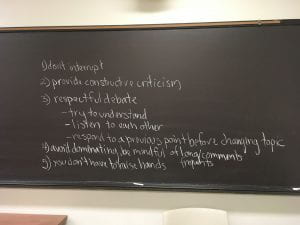Like Samantha, I will be reducing the synchronous element of my class, for precisely the reasons she explains. In addition to these issues of access – students in different time zones, with varying Internet access, loud or not private home environments – which limit students’ ability to learn well sitting uninterrupted in front of a laptop, I also see sound pedagogical reasons for splitting our engagement with each other into live and prerecorded elements.
Given the mix of different elements I imagine using, I will need to plan much of the course in advance. Certainly the structure will need to be planned well, and communicated clearly to students in a medium where they can access it again and again, and ideally where they will receive alerts about what they should be doing (Canvas). I am not undaunted by all this planning.
My intention is to prerecord introductory material – using Panopto, voiceover PowerPoint, or even just plain old Power Point or write it out in a word doc. I am going back and forth on how much students really gain from hearing my voice in these lectures, especially when most technologies that involve voice also require greater bandwidth, but I’ll put that question aside for now.
Prerecorded introductory material is exciting to me for at least two reasons: first, it gives students the opportunity to rewind or review if they miss something, which they might actually do if they perceive the text as difficult. There is also less of a risk of them mishearing, as they might do in a purely oral lecture. Second, temporally splitting the lecture off from discussion allows students time to reflect. I might conclude each prerecorded lecture with questions for discussion. I might instruct them to listen/read before doing the reading assignment.
In limiting the synchronous elements, I am also increasing the time each individual student has to share ideas. Through weekly individual “meetings,” students will have 10-15 minutes of uninterrupted time to ask questions, share claims, etc. With twice weekly discussion posts, students will be writing more regularly than I normally require, and I will respond more regularly by engaging more actively and publicly with their discussion posts.
The weekly schedule for my course might look something like this:
Friday evening: introductory material (lecture) posted on Canvas
Before Tuesday: students view/read introductory material, do reading assignment, and respond to discussion questions on Canvas
Tuesday: 20-25 minutes synchronous discussion in groups of 6 or fewer
Tuesday evening: discussion questions posted on Canvas
Before Thursday: do reading assignment, respond to discussion questions on Canvas
Thursday/Friday: 10-15 minute one-on-one conversations with students, via Skype or phone. These meetings will also give me an opportunity to advise students on writing assignments and just generally check in with them.
I share this only to offer one way of doing things. It won’t work for every class, but I am hoping that it will work for mine.



Sounds like a great plan, Valerie! I like the weekly phone/Skype calls, though depending upon enrollments that could be pretty daunting to institute across two courses.